Angels Light at Gateway Plaza
Publi "Angel Lights" are authentic replicas of art deco lampposts
that are identical to the outdoor fixtures at the original
Cruise Ship Terminal and Matson Terminal during the 1950s.
Publi "Angel Lights" are authentic replicas of art deco lampposts
that are identical to the outdoor fixtures at the original
Cruise Ship Terminal and Matson Terminal during the 1950s.
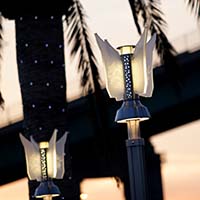
This bronze abstract sculpture recalls the Los Angeles Harbor's importance to the shipping industry and the Angel's Gate Lighthouse at the harbor entrance. Twin spires above the central container ship image evoke the shape of the nearby Vincent Thomas Bridge. Designed by John Okulick and Chad Ben-Artzi, the sculpture was installed as part of the Beacon Street Redevelopment in 1994.
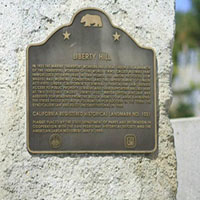
The benches along the promenade are a mix of metal, granite and traditional wood with a nautical theme.
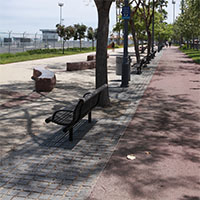
Created by local San Pedro artist Harold Greene, bench seating and wood tables feature inlaid nautical flags that correspond to a letter in the alphabet. At each table corner, flags spell out P-O-L-A for Port of Los Angeles, in addition to the following names:
Table 1: Cabrillo, Dana, Vizcaino, Byrd
Table 2: Banning, White, Hamilton, Miner
Table 3: Timms, Gibbon, Temple, Stearns
Table 4: Stewart, Meyler, Kerckhoff, Braun
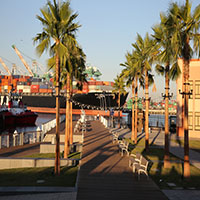
Harold Greene's artistic benches incorporate designs reflecting nautical and Port environmental themes. Utilizing exotic and long lasting hardwoods and finish joinery. These benches give a warm and humanistic touch.
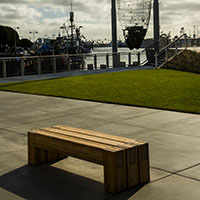
Decorating the upper deck of the promenade are 23 one-of-a-kind ceramic tile concrete seat benches that reflect the local interests, mood, multiculturalism and waterfront character of the harbor area, created by seven local artists Adrian de la Pena, Veralee Bassler, Trace Fukahara, Roberto Delgato, Stuart Bender, Frank Charles, Dante Minuto, and Slanguage selected by a panel of their peers.
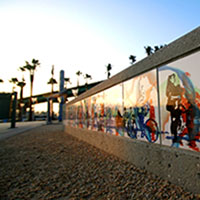
Created by artist Carl Cheng, the "Ghost Fish 107" sculpture is a 40-foot blue fin tuna hung from a galvanized steel frame over the water at Berth 73, next to Utro's Restaurant. Recalling San Pedro's long history as a commercial fishing hub, the sculpture incorporates aluminum and glass cast objects and artifacts gathered from local fishermen. A solar-powered camera and video screen capture the viewer's image in the fish's eye.
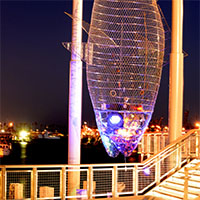
Created by artist Henry Alvarez and built in 2001 by the Terminal Islanders, Inc., a group of past residents and their families, this memorial monument is dedicated to the former residents of the Fishing Village on Terminal Island, home to hundreds of Japanese American families who were relocated to internment camps during World War II. This memorial honors the Terminal Islanders Club Issei parents and preserves the memory of their Furusato, "Home Sweet Home."

Created by artist Henry Lion, this Federal Art Project was completed in 1936 under the New Deal Depression Era Work Projects and honors famous explorer Juan Rodriguez Cabrillo, who in 1542, was the first to see and name this natural harbor Bahia de los Fumos, or Bay of Smokes when this coastline was little more than a swampy marshland. Nearly 500 years later, the Port of Los Angeles is one of the busiest and most successful manmade harbors in the world.
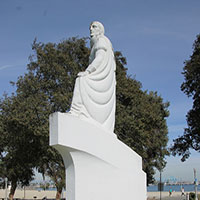
This memorial park is home to three important memorials: the American Merchant Marine Veteran Memorial commissioned by local seaman to honor marine veterans from all wars; the USS Los Angeles Naval Memorial which features the heavy cruiser ship's mast, two anchors and one anchor chain capstans (LACHM No. 188); and the Fishing Industry Memorial commissioned by volunteer fishermen and their descendants to preserve the history of the local fishing industry.
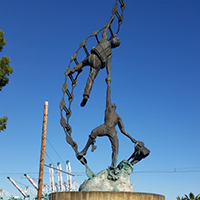
Donated by the City of Ischia, Italy to the Los Angeles community of San Pedro, the Monument to Multiculturalism or "Multicultural Man" statue by artist Fancesco Perilli is a symbol of peace, unity, and cultural diversity. The human figure depicts a universal man, faceless without anything that can identify a race or ethnic group or national costume. Identical statutes are displayed in South Africa, Bosnia, China, and Australia.
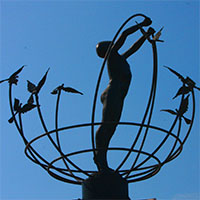
General Phineas Banning is best known as the "Father of Los Angeles Harbor." Sculptor Eugene Daubs created this seven-foot tall bronze statue portraying Banning with his sleeves rolled up and a coil of rope slung over one shoulder to capture his industrious nature.

Each letter is depicted with an alphabet sailing term. Follow the path, to learn nautical terms from A to Z.
A: Apparent Wind
The direction of wind relative to the speed and direction of the boat.
B: Boom
A horizontal spar attached to the bottom edge of a sail.
C: Capstan
A drum or barrel shaped device operated by hand or motor used to haul in heavy anchor chains.
D: Dorade
A horn type of vent designed to let air into a cabin while keeping water out.
E: Eye Splice
A loop in the end of a line formed by braiding the end of the line into itself.
F: Fathom
A measurement relating to the depth of water. One fathom equals six feet.
G: Gimbal
Fixtures that allow objects to swivel and remain level in rough seas.
H: Halyard
Light lines used to hoist signals and flags.
I: Inspection Port
A small watertight covering used for inspecting or removing water from the hull.
J: Jack Line
A strong line or wire stay along the side of a boat for attaching a safety harness.
K: Keel
The center timber at the bottom of a boat’s hull to which the frames are attached.
L: Leeway
The sideways motion of a boat, pushed by the wind or a current.
M: Masthead Fly
A weathervane or wind indicator at the top of a mast.
N: Nautical Mile
One minute of latitude or approximately 6,076 feet, around 1/8 longer than the statue mile of 5,280 feet.
O: Outhaul
A line used for adjusting tension at the foot of the sail along the boom.
P: Pelorous
A navigational instrument similar to a compass, used for taking bearings.
Q: Queen Topsail
A small stay sail located between the foremast and mainmast.
R: Ratlines
Rope steps made of small lines tied across the shrouds: the crew can climb a loft on them.
S: Scuppers
Drains or openings to allow the flow of rough seas over the deck.
T: Telltales
Short strings of yarn attached to the shroud, used as indicators of wind direction.
U: Uphaul
A line or wire used to control the height of a spinnaker pole.
V: Veer
A shifting of the wind direction, clockwise in the northern hemisphere, opposite in the southern hemisphere.
W: Wind Scoop
A funnel used to force wind into a hatch and ventilate the below deck areas.
X: Xebec
A small ancient Mediterranean pirate ship which has three masts.
Y: Yankee
A fore-sail which flys above and forward of the jib usually seen on bowspirit vessels.
Z: Zenith
A navigational term for the point of the celestial sphere which is directly overhead.

"The Ship Chandler" by artist Mark Dion, the official art piece of Downtown Harbor, is an approximate 9-by-12-foot cabin comprised of salvaged materials that represent 19th Century Port of Los Angeles. Designed to be viewed from the outside looking in, the structure is located in the plaza area near the Los Angeles Maritime Museum. Inside the chandler, one can see old shipping artifacts and nautical items.
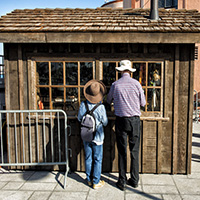
Created by artist Douglas Tilden, this statue depicts U.S. Senator Stephen White who pushed for federal support of the Port of Los Angeles at San Pedro Bay. In the late 1880s there was a great political struggle for an "official" port location. The Great Free-Harbor Fight was one of the greatest struggles for control of West Coast cargo transportation in the history of the United States. Some say, Phineas Banning may have been the father of the Port, but Stephen M. White was certainly its savior.
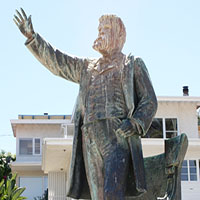
Story ropes were built into Harbor Boulevard Parkway to tell the history of the Port of Los Angeles. Beginning with the discovery of San Pedro by Cabrillo and ending with today's working Port, these historical accounts are displayed in polished granite insets that adorn the promenade. Each of the 11 vignettes highlights important historical milestones in the Port's history. The story begins at 5th Street and continues to the World Cruise Center.
A: Bay of Smokes
B: San Pedro Names
C: Railroad Connects San Pedro
D: Fishing Industry
E: San Pedro Annexed By Los Angeles
F: Canneries
G: Ferry Service
H: Lumber
I: Petroleum
J: Ship Building/Shipyards
K: Maritime Trades
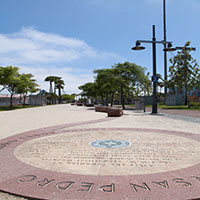
"Telltales" by sculptor Doug Hollis is an environmental art installation at the Cruise Ship Promenade that features a wind ensemble of sculptures that move and create sounds with the ocean breezes. The large-scale kinetic installation can be thought of as environmental indicator amplifying the sensory awareness of the environment.
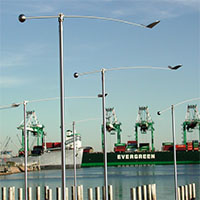
Wilmington Waves is an LED light display by artist Sidier Hess that runs along all of the pedestrian bridges at the Wilmington Waterfront Park. A series of rope LED lights are suspended along railings of the pedestrian bridges, and are illuminated from dusk to dawn.
